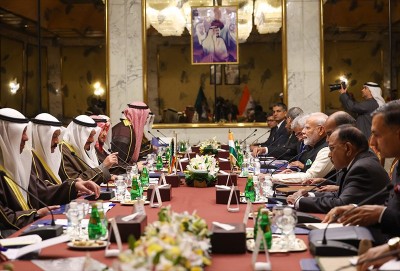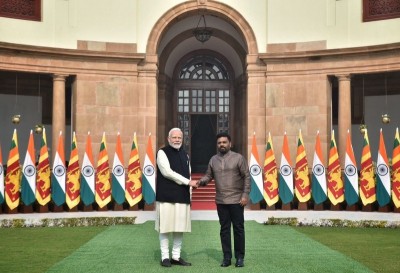 Rajnath Singh
Rajnath Singh
Broad India-China consensus to resolve differences is proof that continuous dialogue brings solutions, says Rajnath Singh
Indian Defence Minister Rajnath Singh on Thursday said a broad consensus achieved by India and China to resolve their differences in certain areas along LAC is a proof that continuous dialogue brings solutions.
Speaking at the Chanakya Defence Dialogue in New Delhi, Singh said the two countries have been involved in talks at diplomatic and military levels, and broad consensus has been achieved to restore the ground situation based on the principles of equal and mutual security.
"This is the power of engaging in continuous dialogue," he said.
He made the comments at a time when Prime Minister Narendra Modi and Chinese President Xi Jinping held bilateral talks in Russia on Wednesday for the first time since 2019.
Relations between India and China touched a low in 2020 during the military clash in Ladakh's Galwan due to Beijing's "unilateral" actions of violating the Line of Actual Control, the de-facto boundary between the two countries.
PM Modi and Xi Jinping held bilateral talks in Kazan on the sidelines of the BRICS Summit.
The meeting follows the successful patrolling arrangement between India and China along the Line of Actual Control, which has faced multiple turmoils over the last few years.
Sharing his insights on the topic ‘India’s Vision for Development & Security’, Singh stated that ‘development’ and ‘security’ are often viewed from separate perspectives, but are, in actuality, deeply interconnected & mutually reinforcing.
“Historically, the study of key factors for economic development such as land, labour, capital and entrepreneurship have been central to economic analysis. The impact of defence and security has traditionally been under explored. This may be because security is often viewed as a necessary but non-economic factor. Defence spending, military infrastructure and national security can significantly affect economic growth and resource allocation, even in non-war periods or in peacetime,” he said.
Rajnath Singh emphasised that a significant portion of any nation’s budget is dedicated to security, with the sector itself making a vital economic contribution through job creation, technological advancements, and infrastructure development.
He reiterated Prime Minister Narendra Modi-led Government’s resolve to bridge the gap between ‘development’ and ‘security’, stressing that economic development can only flourish when national security is ensured.
Enumerating the steps being taken by the Government, Singh said the vision of border area development is based on bolstering the security apparatus and ensuring socio-economic progress of the regions.
This, in turn, fosters economic growth, he stated.
Rajnath Singh also pointed out that indigenous manufacturing of arms and equipment not only strengthens the security infrastructure, but also creates employment opportunities and furthers expertise leading to technological innovation & self-reliance. Additionally, domestic production boosts income generation and stimulates economic activity through supply chains, creating a ripple effect that benefits the entire economy. Initiatives in the name of security often serve as powerful catalysts for broader national development, he said.
Singh highlighted that the Government’s consistent efforts to attain ‘Aatmanirbharta’ has directly linked the defence sector with the nation’s development.
“If defence had been recognised as an integral component of development and studied more comprehensively in the past, India might have achieved self-reliance in the sector much earlier. The prolonged dependency on imports can be attributed, in part, to the lack of a coordinated approach between defence and development. Consequently, while our defence industry missed out on critical opportunities for growth and innovation, a significant portion of our defence budget flowed into other economies, limiting our ability to strengthen our own capabilities. Addressing this disconnect is essential for fostering a robust domestic defence industry that can contribute to national security and economic independence,” he said.
Rajnath Singh, however, clarified that self-reliance does not mean working in isolation from the global community; it is the country’s dedication to foster an equitable and inclusive world order.
He reasserted India’s commitment to collaborating closely with all nations to promote a fair and just international system.
“Our journey toward self-reliance is not a step toward alienation. Rather, it marks the beginning of a new chapter characterised by collaboration and partnership with the global community. We believe that self-reliance will empower us to contribute more effectively to international efforts, share our expertise, and engage in meaningful exchanges that benefit all. Together, we can build a stronger, more inter-connected world that respects the sovereignty and aspirations of every nation on equal terms,” Singh said.
What was the Galwan clash?
On June 15, 2020, Indian and Chinese troops engaged in a six-hour clash in the rugged terrain of Ladakh, engaging in hand-to-hand combat with makeshift weapons such as stones, batons, and iron rods.
The face-off occurred in near-complete darkness and freezing temperatures, leading to fatalities as soldiers fell or were pushed from ridges.
Twenty Indian soldiers were martyred in the clash, while China officially acknowledged four casualties, although reports indicate higher Chinese losses, as soldiers drowned in the choppy waters of the Galwan River.
Support Our Journalism
We cannot do without you.. your contribution supports unbiased journalism
IBNS is not driven by any ism- not wokeism, not racism, not skewed secularism, not hyper right-wing or left liberal ideals, nor by any hardline religious beliefs or hyper nationalism. We want to serve you good old objective news, as they are. We do not judge or preach. We let people decide for themselves. We only try to present factual and well-sourced news.







